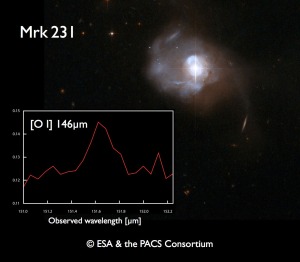ESA put out a major release today showing the first results from the spectrographs on Herschel. The release includes data on the Orion star formation region, on nearby and distant galaxies, on a massive star about to become a supernova and on a comet in our own solar system. The latter set of data was taken with HIFI before the technical fault that has left it shut down, awaiting a restart early next year.
These spectroscopic observations show the huge potential of Herschel to show us the physical and chemical processes going on inside dusty objects, be they star formation regions in our own galaxy, or in luminous interacting galaxies like Arp220 and Mrk231. My own research interests are more focussed on the distant luminous objects, and the data shown here from two archetypical ULIRGs (Ultraluminous Infrared Galaxies) are really spectacular. Never before have we seen the rich range of spectral lines that PACS and SPIRE have revealed in these objects.
PACS also holds out the hope of examining the velocity structure of some of these lines. This is particularly interesting in Mrk231 which hosts not only a massive burst of star formation but also a supermassive black hole powering a hugely luminous active galactic nucleus (AGN). The relationship between galaxy interactions and mergers in triggering both starbursts and AGNs is a hot topic, and Mrk231 makes an ideal testbed.
Finally, for sheer spectral richness and complexity, the PACS spectrum of the massive star VYCMa takes some beating. There’s a huge amount of physics and chemistry in this spectrum of a star deep into its old age and soon to become a supernova. Unfortunately this isn’t my area, so hopefully someone will add comments describing what the data means for this object.
For more information and coverage of these results see the ESA web release, BBC News Online, and the SPIRE website at Cardiff University.



0 comments:
Post a Comment